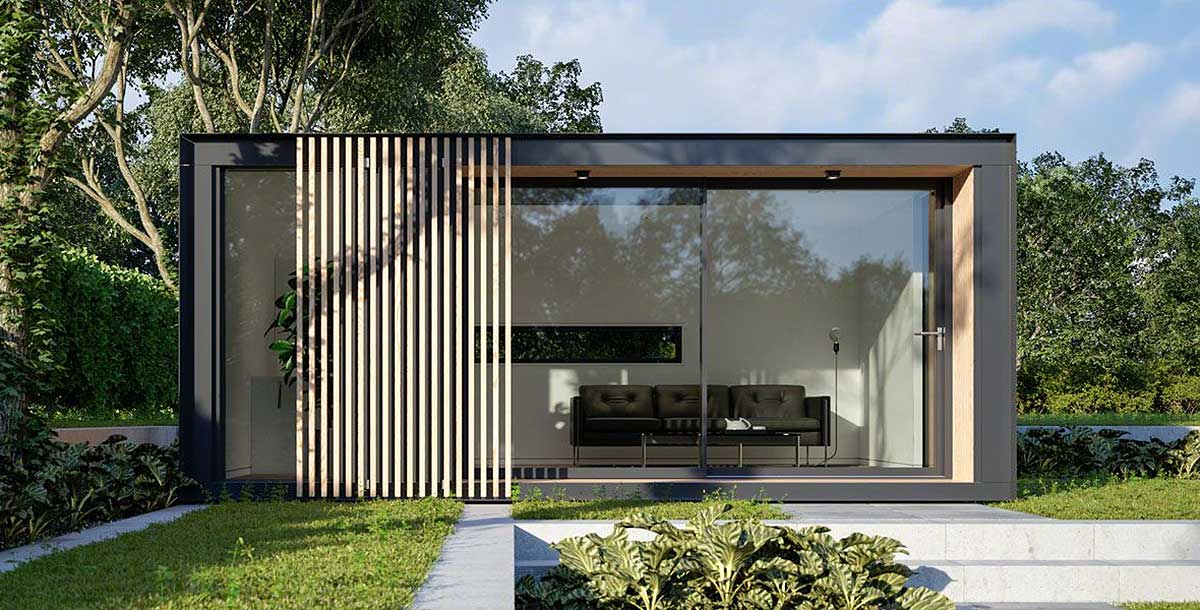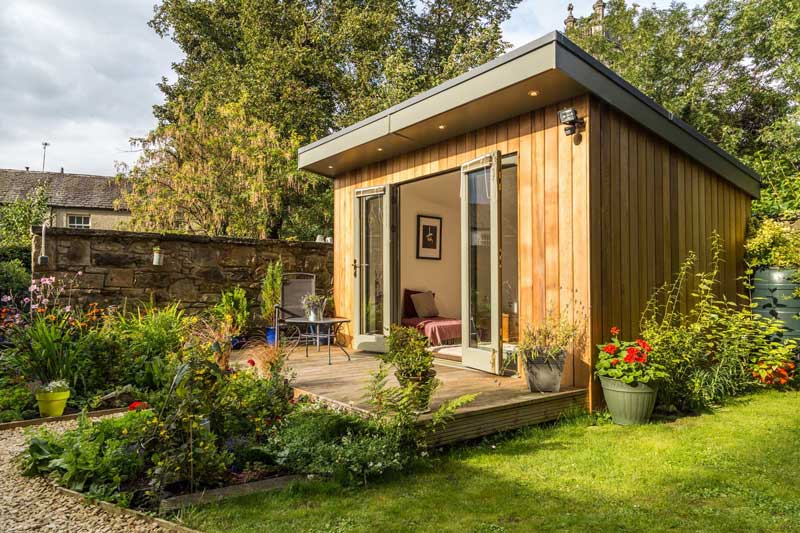The notion of "change in use" is important when constructing garden offices, conservatories, or outhouses. The following are some key points to consider when obtaining planning permission to change the usage:
Planning permission is usually required if you plan to transform an existing non-residential building (such as a garage, agricultural building or garden office) into a residence or garden office. This is due to an alteration in the usage classification of the building.
The Garden Rooms are Living Space:
The possibility of using a garden room for a separate living space (e.g. as a rental unit, guesthouse or similar arrangements) is a change of use. It is required to get permission to plan the area in order to ensure that a building is in compliance with the standards for residential use.
Business Use
If you intend to utilize the garden space or conservatory for business purposes (e.g. for example, as an office space for an office-based business at home that has frequent guests or employees) Planning permission may be required. This is due to the impact it will impact the surrounding area including noise, traffic and parking.
Educational or Community Use
Changing the use of a garden structure into a community or educational space (such as an auditorium or a meeting space) is also a requirement for permission for planning. Local councils will determine the appropriateness and the impact of the proposed location.
Impact on local infrastructure
Planning permission is required for any changes to use that have a significant impact upon local infrastructure. The local planning authority will consider these impacts in the process of applying for permission.
Dual Use
Planning permission might be required for mixed-use properties (such as an apartment that is commercial and residential). This can help to clearly define different uses on the property.
Increased Footfall:
If the changes are likely to result in an increased foot or traffic for example, converting a garden into a small shop space and so on, a planning permit will be required to handle any possible impacts on the location.
Building Regulations Conformity:
It is vital to keep in mind that even though a change in use does not require the approval of a permission to plan, it should be in compliance with all building codes and regulations. These are required to protect people, their health, and also for energy efficiency. This is relevant in particular for conversions of non-habitable spaces to areas that are habitable.
Environmental Impact:
Changes in the use of land that may have an impact on the environment, for instance as the conversion of agricultural land into an area for residential development is likely to require permission for planning. Environmental assessments might be required as part of the application.
Community and Amenity Effect
It is essential to consider the effect that this change will have on the community amenities in the area and the general character of the place. Planning permission will be needed to convert the garden into a cafe, for example to ensure that it is aligned it with the local plan and preserve the local amenities.
Designated Zones:
In conservation zones, National Parks (AONB), or Areas of Outstanding Natural Beauty Changes in usage are subject to greater scrutiny in order to protect the nature of the region. In these situations, planning permission is required.
Local Planning Policies
Local planning authorities could have different policies regarding changes in usage. It is recommended to read these policies to know what types of changes are allowed and what requirements need to be met.
Planning permits are often needed for any significant modification in the purpose or place of a gardenroom, conservatory outhouse, office or extension. This ensures that the new usage is suitable for the location and is in line with the local and national policies on planning. It also addresses any possible impacts on the environment and community. Consult your local planning authority at the earliest possible point during the planning stage to determine the needs and to obtain the necessary approvals. Check out the recommended build your own composite garden room for site info including insulated garden rooms, outhouses, costco garden rooms, what size garden room without planning permission, garden rooms, gym outhouse, garden buildings , armoured cable for garden room, composite garden rooms, garden room vs extension and more.

What Kind Of Planning Permission Will You Require To Construct A Garden Room, For Instance?
If you're planning to build conservatories, garden offices outhouses, or garden offices The concerns of your neighbors will decide whether you need planning permission. Two important considerations overlooking and privacy
Planning permission may be needed in the event that the construction will cause a reduction in private space. This is to ensure that the building won't negatively impact the living conditions of those living close to.
Overshadowing and loss of light:
A planning permit is typically required if the proposed construction will cause significant light loss or shadowing of nearby properties. The local planning authority will decide the impact of the proposed structure on daylight and sunlight in the adjacent property.
Noise and Disturbance
Planning permission is required if a garden room or extension is planned intended to be used for noisy activities (such as guests visiting your home office or a music studio, or a workshop, etc.). The volume of the noise has to be acceptable to neighbors and should not create disturbance.
Visual Impact and Character
The size, design and style of a brand new structure must be in harmony with the surrounding neighborhood. Planning permits ensure visual appeal and that the new development does not harm the aesthetics in the neighborhood.
Boundary Proximity
Planning permission might be required for buildings that are built close to the boundary of a property in particular in the case of structures that are higher than 2,5 meters, and is within 2 meters. It is done to prevent conflicts and adverse impacts on neighboring properties.
Shared Access Rights and Rights of Way
In order to avoid obstructing or negatively impacting shared access points, rights of way, or even constructions, planning approval is needed.
Objections from Neighbors:
People living in the immediate area are entitled to consult on planning applications. Planning authorities will take into account the objections of neighbors when deciding whether or not to grant permission.
Impact on Values of Properties:
While not always a primary consideration, significant changes that may affect the properties of neighbouring houses may affect the necessity to obtain planning permission. Local authorities will consider these impacts when deciding.
Covenants and Deed Restrictions:
There may be covenants or restrictions placed on the property that need to be adhered to regardless of approval for planning. Legal agreements can determine what type of construction is allowed and cannot take place that could impact the harmony of the neighborhood.
Construction Disturbance:
The planning permit can deal with the issues of disturbances that may happen during the construction phase like dust and noise. To reduce the impact of construction on nearby neighbors, certain conditions could be set.
Impact of Infrastructure
If the new structure puts an additional burden on the local infrastructure (e.g. drainage or parking and road use) Planning permits should make sure that these effects are assessed and appropriately managed.
Community Consultation
In certain cases, it may be necessary to engage with a larger group especially when it comes to larger or more controversial projects. This allows a more democratic method of decision-making that considers local opinions.
In short, the neighborhood's concerns play a significant role when it comes to planning permission for conservatories, garden rooms outhouses, garden offices or extensions. Making sure that the development proposed does not negatively impact the living conditions and lighting, privacy, noise levels, and overall character of the area is crucial. Consultation with the neighborhood planner and involving neighbors early in the planning process can help address these issues and facilitate the process of approving the project. See the best planning permission for garden rooms for website tips including garden rooms brookmans park, garden room permitted development, garden room conservatory, garden rooms hertfordshire, small garden office, garden outhouses, outhouse uk, what size garden room without planning permission, costco outhouse, outhouses and more.

What Planning Permission Do You Need For Garden Rooms Etc.?
If you are planning to build gardens, conservatories outhouses, office or extension The appearance and style will play a major role in determining whether you need planning permission. Here are some key things to think about:
Planning permission is not required if you are able to construct the structure within the allowed development rights on your property. There are some aesthetic and design criteria which must be fulfilled.
Size and Scale
The dimensions and size must be proportional to the property's size and the buildings. Planning permission is required for structures that are larger than the limits set out in the permitted development rights.
Massing and height
The size and height of the new structure must be in keeping with the size of the existing property and adjacent buildings. Planning permission is usually required for structures exceeding the height limit or not in scale with the buildings around it.
Materials and Finishes:
The selection of materials and finish should complement the existing property and surrounding buildings. Planning permission may be required if proposed materials are not in keeping with the local style and style.
Design Harmony
The design for the new structure must be in line with the architectural style that is in place. If the design that is proposed does not match the local appearance and character the planning approval will be needed.
Roof Design
The roof design should match the design of the adjacent property and the surrounding buildings. If the proposed design of the roof is not in character with the surrounding area the planning permission might be needed.
Fenestration (Windows and Doors):
The design and placement of doors and windows should be in harmony with the current property and adjacent buildings. If the proposed fenestration is not fit with the local style or character the planning permission might be required.
Facade Treatment
The way the facade is treated should be consistent with the property's existing appearance and buildings around it. If the proposed design of the facade isn't in keeping with the local appearance and design, planning permission might be required.
Landscape and the Surroundings
Landscape design around a new building must be harmonious with the surrounding structures as well as existing structures. If the proposed landscaping isn't in line with the neighborhood, then planning permission may be needed.
Visual Impact
The visual impact of the new structure should be as minimal as possible. If the proposed structure has negative effects on the surrounding area the planning permission might be needed.
Heritage and Conservation Areas
If a property that is located within an area designated as an historic site or to preserve its natural beauty, design and aesthetic criteria might be more stringent. If any new structures do not conform to the above standards the need for a planning application could be necessary.
Architecture and Guidelines for Planning
Local planning authorities often have their own design and style guidelines that must be followed. Planning permission might be needed in the event that a proposed building is not in line with these guidelines.
Summary: Planning permission for garden rooms and conservatories as well as outhouses, office buildings or extensions, is often dependent on the design the appearance and the size of the proposed structure. It is essential to consult early on with the local authorities to determine whether or not planning permission is necessary and make sure that the plan is compatible with local guidelines for character. Take a look at the most popular extension or garden room for website recommendations including outhouse builders, how to lay decking on soil, garden room permitted development, outhouse garden, garden office, garden room, outhouse builders, armoured cable for garden room, garden office, composite garden rooms and more.
